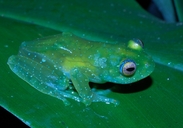|
Boophis luciae Glaw, Köhler, De la Riva, Vieites & Vences, 2010
Subgenus: Boophis | family: Mantellidae subfamily: Boophinae genus: Boophis |
| Species Description: Glaw F, Koehler J, de la Riva I, Vieites DR, Vences M 2010 Integrative taxonomy of Malagasy treefrogs: combination of molecular genetics, bioacoustics and comparative morphology reveals twelve additional species of Boophis. Zootaxa 2382:1-82. | |
 © 2012 Sebastian Wolf (1 of 6) |
|
|
|
Description It is ascribed to the genus Boophis based on the following combination of characters: intercalary element present on the last two fingers and toes; no femoral or gular glands in males; axillary amplexus; expanded fingertips and toe tips; webbing between the lateral metatarsalia; no outer metatarsal tubercle. It is considered part of the B. albipunctatus group separate from other Boophis species based on the following combination of characters: small size; no tubercles or flaps on the heels and elbows; webbed fingers; faint canthus rostralis; radiant green back with white dots; no red coloration on the underside; non-transparent skin on the underside in life; one vocal sac; presence of vomerine teeth. Within the B. albipunctatus group, it is similar to B. albipunctatus and B. sibilans by the following combination of characters: prominent brown marks on the iris; presence of small prominent white spots on the back. Furthermore, B. luciae can be differentiated by these two similar species by its smaller body and advertisement call (Glaw et al. 2010). In life, the backside is bright green and punctuated with small white dots. Some brown dots are found on the head and back, particularly by the sides of the middle of the back. The posterior region of the sides is transparent. The skin on the underside is transparent, with a white peritoneum. The underside of the limbs is transparent blue. The iris is gold, with an orange border and purple markings. The border of the eye is black towards the rear, then blue, and then black again. In alcohol, the backside is creamy yellow, and the spots turn dark in color. There are small brown spots on the middle of the back and by the nostrils. The rear part of the eye is purple (Glaw et al. 2010). The females are larger in size than the males. The males have a vocal sac (Glaw et al. 2010). Distribution and Habitat Country distribution from AmphibiaWeb's database: Madagascar
Life History, Abundance, Activity, and Special Behaviors There are three different call types that also vary based on locality. Type 1 is composed of long trill notes in regular intervals of 5 - 10 pulses. At Ranomena note durations are 146 - 201 ms with inter-note intervals last between 288 - 497 ms, and a note repetition rate of 1.7 - 2.0 notes/second. At Vohiparara, note durations are 152 - 213 ms with inter-note intervals last between 250 - 529 ms, and a note repetition rate of 1.6 - 2.0 notes/second. Type 2 is composed of 9 - 13 whistles in short intervals. At Ranomena note durations are 18 - 101 ms with inter-note intervals last between 39 -106 ms, and a note repetition rate of 7.5 -9.8 notes/second. At Vohiparara, note durations are 23 - 81 ms with inter-note intervals last between 62 - 103 ms, and a note repetition rate of 6.6 - 7.6 notes/second. Type 3 is composed of 3 - 6 click notes with long separations in between followed by whistling. At Ranomena note durations are 15 - 39 ms with inter-note intervals last between 395 - 527 ms. At Vohiparara, note durations are 26 - 41 ms with inter-note intervals last between 467 -599 ms. Dominate frequency ranged from 3000 - 4500 Hz with a maximum call energy of 3600 - 4300 Hz at Ranomena and was 2950 - 3900 Hz and 3150 - 3800 Hz at Vohiparara, respectively (Glaw et al. 2010). Amplexus is axillary (Glaw et al. 2010). Trends and Threats Possible reasons for amphibian decline General habitat alteration and loss Comments It is ascribed to the aforementioned B. albipunctatus species group, which includes B. albipunctatus, B. luciae, and B. sibilans, with B. luciae being basal to the other two species. This provides evidence for the existence of two subclades supported by morphological and molecular data, with the first subclade comprising B. ankaratra, B. schuboeae, and allied species, and the second subclade comprising the B. albipunctatus species group. Boophis luciae has a genetic divergence of 4.8 – 6.2% from B. sibilans, and 6.4 – 7.6% from B. albipunctatus in the mitochondrial 16S rRNA region (Glaw et al. 2010). The species epithet, luciae, is named after Ignacio De la Riva’s daughter, Lucia, as an apology for working abroad (Glaw et al. 2010). Boophis luciae has been called Boophis sp. aff. sibilans and Boophis sp. in previous publications (Glaw et al. 2010).
References
Glaw, F., Kohler, J., De La Riva, I., Vieites, D.R., Vences, M. (2010). "Integrative taxonomy of Malagasy treefrogs: combination of molecular genetics, Bioacoustics and comparative morphology reveals twelve additional species of Boophis." Zootaxa, 2383, 1-82. [link] Originally submitted by: Henry Ascencio (first posted 2015-08-13) Edited by: Gordon Lau and Ann T Chang (2021-07-29) Species Account Citation: AmphibiaWeb 2021 Boophis luciae <https://amphibiaweb.org/species/7462> University of California, Berkeley, CA, USA. Accessed Nov 26, 2024.
Feedback or comments about this page.
Citation: AmphibiaWeb. 2024. <https://amphibiaweb.org> University of California, Berkeley, CA, USA. Accessed 26 Nov 2024. AmphibiaWeb's policy on data use. |



 Map of Life
Map of Life